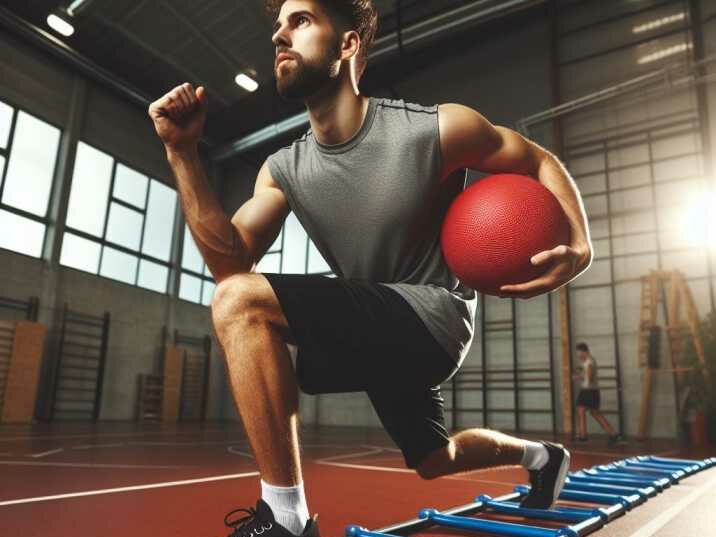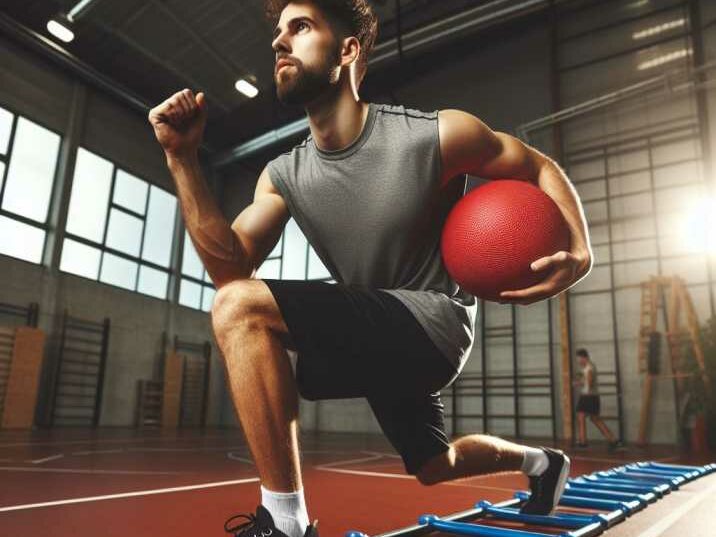Introduction:
Table of Contents
Dodgeball isn’t just a fun game to play; it’s also a fantastic way to improve your coordination and balance. Whether you’re a beginner or a seasoned player looking to enhance your skills, incorporating specific training techniques can take your game to the next level. In this article, we’ll delve into six dodgeball training techniques that will help you enhance your coordination and balance, allowing you to dodge, duck, dip, dive, and dodge with precision.
Techniques for Enhancing Coordination and Balance:
1: Agility Drills
Agility drills are essential for improving your coordination and balance on the dodgeball court. Incorporate exercises like ladder drills, cone drills, and shuttle runs into your training regimen to enhance your footwork and reaction time. These drills help you develop the quick movements and sharp reflexes needed to evade incoming balls while maintaining balance.

Ladder Drills
Ladder drills involve fast-paced footwork exercises performed on a ladder-shaped agility ladder. Practice various patterns, such as the two-feet-in, two-feet-out drill or the side shuffle, to improve your agility and balance. Focus on maintaining proper form and speed to challenge yourself and maximize results.
2: Core Strengthening Exercises
A strong core is crucial for maintaining stability and balance during dodgeball games. Incorporate core strengthening exercises like planks, Russian twists, and bicycle crunches into your workout routine to build a solid foundation. A strong core will help you stay grounded and react quickly to incoming balls.
Planks
Planks are an effective core strengthening exercise that targets the abdominal muscles, lower back, and shoulders. Hold the plank position for 30 seconds to one minute, focusing on maintaining a straight line from head to heels. Repeat for multiple sets to build endurance and stability. Variations such as side planks and plank with leg lifts can further challenge your core muscles and improve overall stability.
3: Hand-Eye Coordination Drills
Hand-eye coordination is essential for effectively catching and throwing dodgeballs. Practice hand-eye coordination drills such as ball tosses against a wall, juggling, or playing catch with a partner to improve your ability to track moving objects and react accordingly.
Wall Ball Toss
Stand facing a wall with a dodgeball in hand. Toss the ball against the wall with one hand and catch it with the other. Increase the speed and vary the height and angle of the tosses to challenge your coordination skills. Additionally, try alternating between catching with one hand and two hands to enhance coordination and dexterity.
4: Balance Exercises
Good balance is key to maneuvering swiftly and avoiding falls on the dodgeball court. Incorporate balance exercises like single-leg squats, stability ball exercises, and balance board drills into your training routine to improve your stability and control.
Single-Leg Squats
Stand on one leg with the other leg lifted slightly off the ground. Slowly lower into a squat position, keeping your chest up and your core engaged. Return to the starting position and repeat for multiple reps before switching legs. To increase the challenge, try performing the single-leg squats on an unstable surface like a balance board or cushion to engage more stabilizing muscles and improve balance further.
5: Reaction Time Training
Quick reflexes are essential for dodging incoming balls and seizing opportunities to catch opponents off guard. Incorporate reaction time training drills such as reaction ball drills, mirror drills, and partner drills into your practice sessions to sharpen your reflexes.
Reaction Ball Drills
Use a reaction ball, a small rubber ball with an erratic bounce, for this drill. Stand facing a wall and bounce the ball against it. React quickly to catch the ball as it rebounds in unpredictable directions, challenging your reflexes and coordination. To intensify the drill, incorporate lateral movements or incorporate catching and throwing variations with a partner to simulate game-like scenarios and improve reaction time under pressure.
6: Dynamic Stretching
Dynamic stretching helps prepare your muscles for the dynamic movements required in dodgeball while improving flexibility and range of motion. Incorporate dynamic stretches like leg swings, arm circles, and torso twists into your warm-up routine to reduce the risk of injury and improve overall performance.

Leg Swings
Stand facing a wall or sturdy support and hold onto it for balance. Swing one leg forward and backward in a controlled motion, gradually increasing the range of motion with each swing. Repeat with the other leg. Additionally, perform lateral leg swings and diagonal leg swings to target different muscle groups and improve overall hip mobility. Incorporate arm circles and torso twists to further loosen up the upper body and prepare for dynamic movements during gameplay.
Table of Information:
| Technique | Description |
|---|---|
| Agility Drills | Improve footwork and reaction time. |
| Core Strengthening | Build a strong foundation for stability. |
| Hand-Eye Coordination | Enhance ability to track and catch balls. |
| Balance Exercises | Improve stability and control on the court. |
| Reaction Time Training | Sharpen reflexes for quick reactions. |
| Dynamic Stretching | Prepare muscles for dynamic movements. |
Conclusion:
Incorporating these six dodgeball training techniques into your regimen will not only enhance your coordination and balance but also elevate your overall performance on the court. Whether you’re aiming to dodge incoming balls with agility or catch opponents off guard with lightning-fast reflexes, consistent practice and dedication to these techniques will undoubtedly yield results. So, grab your dodgeball, lace up your sneakers, and get ready to dominate the game with newfound precision and skill.
FAQs:
1. How often should I incorporate these training techniques into my routine?
Aim to practice these techniques at least 2-3 times per week to see significant improvements in your coordination and balance on the dodgeball court.
2. Can beginners benefit from these training techniques?
Absolutely! These techniques are suitable for dodgeball players of all skill levels, including beginners who are looking to develop their coordination and balance from scratch.
3. Do I need any special equipment to perform these training exercises?
While some exercises may require basic equipment like dodgeballs or agility ladders, many can be performed with minimal or no equipment at all, making them accessible to everyone.
4. How long will it take to notice improvements in my coordination and balance?
The timeline for improvement varies from person to person, but with consistent practice, you can expect to see noticeable improvements within a few weeks to a couple of months.
5. Are these training techniques suitable for children?
Yes, these techniques can be adapted to suit children’s skill levels and age groups, making them suitable for young dodgeball enthusiasts looking to improve their coordination and balance.



